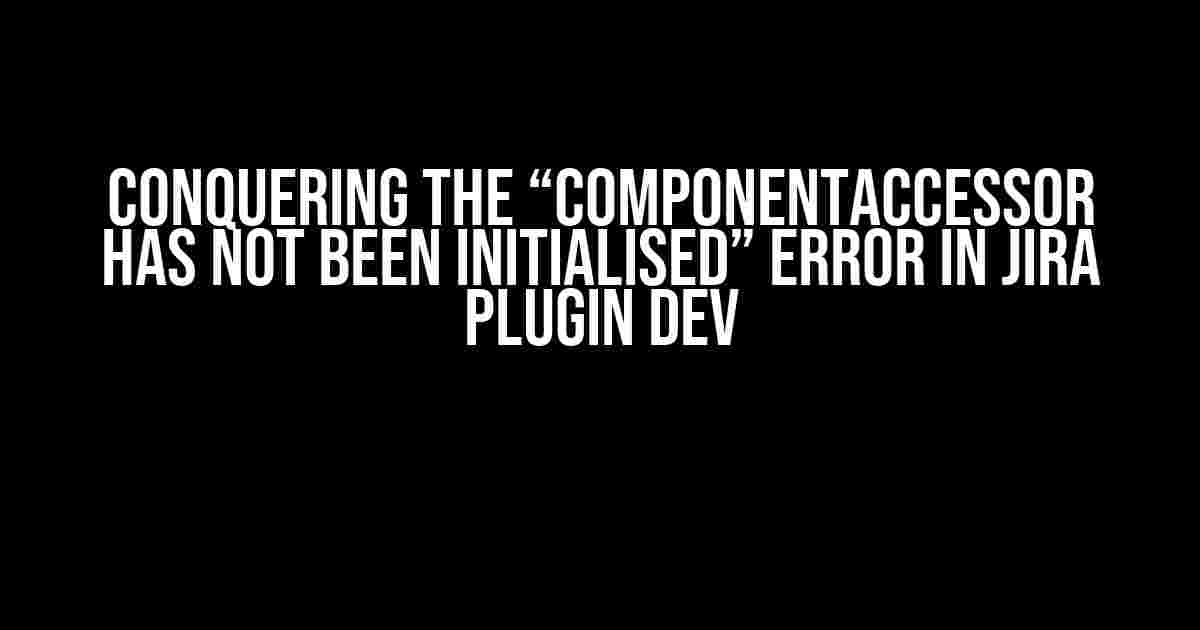As a Jira plugin developer, you’ve likely encountered the infamous “ComponentAccessor has not been initialised” error. This pesky issue can bring your development process to a screeching halt, leaving you frustrated and bewildered. Fear not, dear developer, for we’re about to embark on a quest to vanquish this error and get your plugin up and running in no time!
Understanding the Error
The “ComponentAccessor has not been initialised” error typically occurs when you’re trying to access a Jira component, such as the ApplicationUserManager or IssueManager, before the plugin has been properly initialized. This can happen when you’re attempting to use a component in a constructor or during the initialization phase of your plugin.
The Culprits
There are a few common culprits that can cause this error:
- Incorrect plugin configuration
- Improper component injection
- Usage of components in constructors or initialization methods
Solution 1: Verify Plugin Configuration
Let’s start by ensuring that your plugin configuration is correct. In your atlassian-plugin.xml file, make sure you’ve defined the necessary modules and dependencies. Here’s an example:
<atlassian-plugin key="my-plugin" name="My Plugin">
<plugin-info>
<description>My plugin description</description>
<version>1.0</version>
<vendor-name>My Company</vendor-name>
<vendor-url>https://mycompany.com</vendor-url>
</plugin-info>
<module type="plugin" />
<module type="servlet" class="com.mycompany.MyServlet"/>
<module type="component" class="com.mycompany.MyComponent"/>
</atlassian-plugin>
Solution 2: Proper Component Injection
Now, let’s focus on proper component injection. Instead of using constructors or static methods to access Jira components, use the ComponentAccessor to retrieve the components you need. Here’s an example:
import com.atlassian.jira.component.ComponentAccessor;
public class MyComponent {
private final ApplicationUserManager ApplicationUserManager;
public MyComponent() {
this.ApplicationUserManager = ComponentAccessor.getUserManager();
}
public void doSomething() {
ApplicationUser user = ApplicationUserManager.getUser("myuser");
// Do something with the user
}
}
Solution 3: Avoid Components in Constructors
Another common mistake is using Jira components in constructors. This can cause the “ComponentAccessor has not been initialised” error because the plugin hasn’t been fully initialized yet. Instead, use lazy initialization or inject the components using a method.
public class MyComponent {
private ApplicationUserManager ApplicationUserManager;
public void init() {
this.ApplicationUserManager = ComponentAccessor.getUserManager();
}
public void doSomething() {
ApplicationUser user = ApplicationUserManager.getUser("myuser");
// Do something with the user
}
}
Best Practices
To avoid the “ComponentAccessor has not been initialised” error, follow these best practices:
- Avoid using Jira components in constructors or static methods
- Use the
ComponentAccessorto retrieve Jira components - Initialize components lazily or using a method
- Verify your plugin configuration and dependencies
Troubleshooting
If you’re still encountering the “ComponentAccessor has not been initialised” error, try the following troubleshooting steps:
| Step | Description |
|---|---|
| 1 | Check your plugin configuration and dependencies |
| 2 | Verify that you’re using the correct component injection method |
| 3 | Ensure that you’re not using Jira components in constructors or static methods |
| 4 | Try restarting Jira or redeploying your plugin |
| 5 | Check the Jira logs for any error messages or stack traces |
Conclusion
In this article, we’ve explored the “ComponentAccessor has not been initialised” error in Jira plugin development. By following the solutions and best practices outlined above, you should be able to overcome this issue and get your plugin up and running smoothly. Remember to verify your plugin configuration, use proper component injection, and avoid using Jira components in constructors or static methods. Happy coding!
If you have any further questions or need additional assistance, feel free to ask in the comments below!
Frequently Asked Question
Get the lowdown on the infamous “ComponentAccessor has not been initialised” error in Jira Plugin Dev!
What causes the “ComponentAccessor has not been initialised” error in Jira Plugin Dev?
This error occurs when the ComponentAccessor class is not properly initialised or is accessed before the Jira framework has finished its startup process. This can happen when you’re trying to use the ComponentAccessor in a constructor or a static initializer.
How can I fix the “ComponentAccessor has not been initialised” error in my Jira plugin?
To fix this error, you need to ensure that the ComponentAccessor is initialised after the Jira framework has finished its startup process. You can do this by injecting the ComponentAccessor into your plugin’s components or by using a lazy-loading mechanism to access the ComponentAccessor only when it’s needed.
What are some common scenarios where this error occurs in Jira Plugin Dev?
This error commonly occurs when you’re trying to access the ComponentAccessor in a plugin’s constructor, a static initializer, or a ServletContextListener. It can also occur when you’re using a thread that’s not managed by the Jira framework, such as a Quartz job or a Java thread.
Can I use the ComponentAccessor in a Jira plugin’s constructor?
No, it’s not recommended to use the ComponentAccessor in a Jira plugin’s constructor, as the Jira framework may not have finished its startup process at that point. Instead, use a lazy-loading mechanism or inject the ComponentAccessor into your plugin’s components.
How can I troubleshoot the “ComponentAccessor has not been initialised” error in my Jira plugin?
To troubleshoot this error, check your plugin’s code to see where the ComponentAccessor is being accessed. Look for any instances where the ComponentAccessor is being used in a constructor or a static initializer. Also, check your plugin’s logging to see if there are any other errors or warnings that may be related to the ComponentAccessor.

